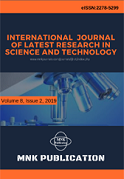DOI:10.29111/ijlrst ISRA Impact Factor:3.35, Peer-reviewed, Open-access Journal
Research Paper Open Access
International Journal of Latest Research in Science and Technology Vol.4 Issue 2, pp 16-22,Year 2015
Correspondence should be addressed to :
Received : 05 April 2015; Accepted : 11 April 2015 ; Published : 30 April 2015

| Download | 125 |
|---|---|
| View | 182 |
| Article No. | 10483 |
Natural extracts from European Cornel fruits have been found to be a significant source of natural antioxidants with health benefits for human body. In the present work we focused on using these extracts for preparing new nanomaterials based on metallic nanoparticles, taking in consideration that these metals have been used for a long time as treatment in medical fields. We have developed a synthesis method which permits to obtain the noble metal nanoparticles having anthocyanins from natural extract as ligands. We have characterized them by UV-Vis spectroscopy, Transmission Electron Microscopy (TEM), Dynamic Light Scattering (DLS), X-ray Diffraction (XRD), Fourier Transform Infrared Spectroscopy (FTIR) and Differential Scanning Calorimetry (DSC). Equilibrium constants of reactions between gold/silver nanoparticles and organic molecules as ligands have been determined in two ways and have been found of 104 orders of magnitude, values that suggest a good association between them. Some new medical products (creams) based on gold/silver-natural extracts have been applied on skin lesions appeared due to the psoriatic illness. The creams prepared have been used on a lot of 31 human subjects with skin lesions and after two months of treatment, a good anti-inflammatory effect has been observed. The good medical results have been confirmed by statistical studies
Copyright © 2015 Liliana Olenic et al. This is an open access article distributed under the Creative Commons Attribution 4.0 International (CC BY 4.0) license which permits unrestricted use, distribution, and reproduction in any medium, provided the original work is properly cited.
Liliana Olenic,Ioana Chiorean , " Synthesis, Characterization And Application Of Nanomaterials Based On Noble Metallic Nanoparticles And Anthocyanins ", International Journal of Latest Research in Science and Technology . Vol. 4, Issue 2, pp 16-22 , 2015

MNK Publication was founded in 2012 to upholder revolutionary ideas that would advance the research and practice of business and management. Today, we comply with to advance fresh thinking in latest scientific fields where we think we can make a real difference and growth now also including medical and social care, education,management and engineering.

We offers several opportunities for partnership and tie-up with individual, corporate and organizational level. We are working on the open access platform. Editors, authors, readers, librarians and conference organizer can work together. We are giving open opportunities to all. Our team is always willing to work and collaborate to promote open access publication.

Our Journals provide one of the strongest International open access platform for research communities. Our conference proceeding services provide conference organizers a privileged platform for publishing extended conference papers as journal publications. It is deliberated to disseminate scientific research and to establish long term International collaborations and partnerships with academic communities and conference organizers.